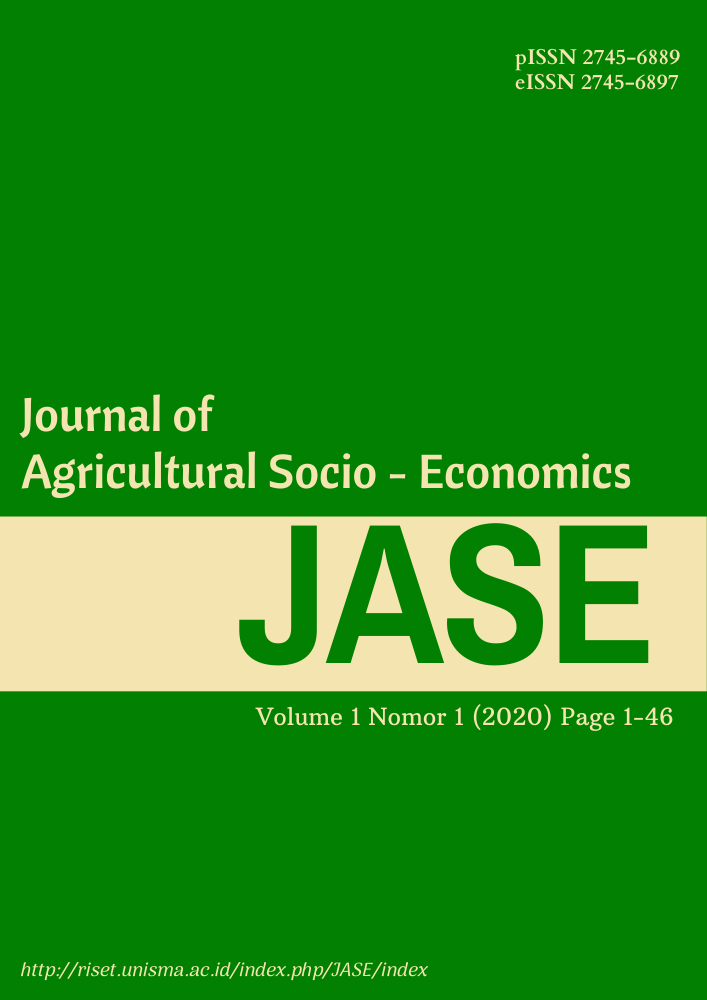Pendapatan dan kelayakan usahatani cabai rawit
DOI:
https://doi.org/10.33474/jase.v1i1.7242Keywords:
chili, farming, feasibilityAbstract
Indonesia is an agrarian country, one of which produces a chili commodity that can support the economy in this country. Chili is one type of horticulture that cannot be left by the community in everyday life. Besides that, chili farming has very good prospects. The purpose of this study was to determine the revenue, income obtained by farmers in one planting season, and the feasibility of chili farming in one season. The results obtained by the total income obtained by farmers in chili farming with an average income of Rp.35,124,800.-The total income earned by farmers in chili farming with an average income earned is Rp.25,204,800,- Chilli Farming in the Village of Kaligambir is worth the effort by looking at the R/C ratio of 2.54, which means that each expenditure of Rp.100.- will receive Rp.254.References
Akhmad Sudrajat, 2002. Pengertian Pendekatan, Strategi, Metode, Teknik, Taktik, dan Model Pembelajaran, yang diakses dari http://psbpsma.org/content/blog/pengertian-pendekatan-strategi-metode-tekniktaktik-dan-model-pembelajaran.
Amewu S, Onumah EE (2015). Cost efficiency of NERICA producing households in Ghana: a modified non-neutral stochastic frontier analysis. Am. J. Exp. Agric. 9(6):1-13
Asante BO, Villano RA, Battese GE (2014). The effect of the adoption of yam minisett technology on the technical efficiency of yam farmers in the forest-savanna transition zone of Ghana. Afr. J. Agric. Resour. Econ. 9(2):75-90
Asravor, J., Onumah, E. E., & Osei-Asare, Y. B. (2016). Efficiency of chili pepper production in the volta region of Ghana. Journal of Agricultural Extension and Rural Development, 8(6), 99-110.
Athipanyakul, T. and Pak-Uthai, W. ‘Determinants of Good Agricultural Practices (GAP) Adoption in the Chili Production System in Northeastern Thailand: A case of Participatory Approach’, International Journal of Environmental and Rural Development, Vol. 3, (2012) pp. 175-180.
Badan Pusat Statistik dan Direktorat Jenderal Hortikultura. 2015. Produktivitas Cabai Menurut Provinsi, 2010-2014. http://www.pertanian.go.id/ Kementrian Pertanian Republik Indonesia.
BPS, 2018. Blitar Dalam Angka. Kantor Statistik Propinsi Jawa Timur
FerraraA.LovelliS.Di TommasoT.PerniolaM.2011Flowering, growth and fruit setting in greenhouse bell pepper under water stressJ. Agron.101219.
Geo, L., Ariani, W. O. R., & Saediman, H. 2020. Determinants and Profitability of Small-Scale Red Chili Production in Konawe District of Southeast Sulawesi.
Herlina. (2010). Minat Belajar. Jakarta: Bumi Aksara.
Khan H, Saeed I (2011). Measurement of Technical, Allocative and Economic Efficiency of Tomato Farms in Northern Pakistan. International Conference on Management, Economics and Social Sciences (ICMESS' 2011) Bangkok Dec., 2011.
Mariano MJ, Villano R, Fleming E (2011). Technical Efficiency of Rice Farms in Different Agroclimatic Zones in the Philippines: An Application of a Stochastic Metafrontier Model. Asian Econ. J. 25(3):245-269.
Mariyono J, Integrated disease management for chili farming in Brebes and Magelang, Central Java: Social economic impacts. Jurnal Sosial Ekonomi dan Kebijakan Pertanian, 2016, 5(2): 114-124
Noor. Hendrifarial, 2007. Ekonomi Managerial. Raja Grafindo. Jakarta.
Onumah JA, Onumah EE, Al-Hassan RM, Bruemmer B (2013). Metafrontier analysis of organic and conventional cocoa production in Ghana. Agric. Econ. 6(59):271-280.
Pandit, B. H., Nuberg, I., Shrestha, K. K., Cedamon, E., Amatya, S. M., Dhakal, B., & Neupane, R. P. (2019). Impacts of market-oriented agroforestry on farm income and food security: insights from Kavre and Lamjung districts of Nepal. Agroforestry Systems, 93(4), 1593-1604.
Prasetya. 2010. Analisis Efisiensi Ekonomi Penggunaan FaktorFaktor Produksi Pada Usahatani Melon di Kabupaten Grobogan. Surakarta. Fakultas Pertanian. Universitas Sebelas Maret.
Saidah, Z., Hartoyo, S., & Asmarantaka, R. W. (2020, March). Change on Production and Income of Red Chili Farmers. In IOP Conference Series: Earth and Environmental Science (Vol. 466, No. 1, p. 012003). IOP Publishing.
Santika, A. 2008. Agribisnis Cabai. Penebar Swadaya, Jakarta.
Schreinemachers, P., Wu, M. H., Uddin, M. N., Ahmad, S., & Hanson, P. (2016). Farmer training in off-season vegetables: Effects on income and pesticide use in Bangladesh. Food Policy, 61, 132-140.
Sihotang,B. 2010. Kandungan Senyawa Kimia pada Pupuk Kandang Berdasarkan Jenis Binatangnya. Kumpulan Artikel Budidaya Tanaman http://pustaka .litbang .deptan.go.id/bppi/lengkap/bpp09037.pdf.√
Soekartawi, A. 1995. Analisis Usahatani. Universitas Indonesia. Jakarta
Soekartawi, 2007. Teori Ekonomi Produksi. Rajawali Press. Jakarta.
Suprioyo. 2002. Macam-macam Biaya Usahatani. Penebar Swadaya. Bandung.
Wosor DK, Nimo F (2012). Resource use efficiency in Chili Pepper production in the Keta municipality of Volta Region of Ghana. Elixir Prod. Manage. 47(2012):8595-8598
Downloads
Published
How to Cite
Issue
Section
License
JASE: Journal of Agricultural Socio-Economics with a registration number of ISSN xxxx-xxxx (printed) and xxxx-xxxx(online) published by the Department of Agribusiness, Faculty of Agriculture at the University of Islam Malang by applying for copyright and License.
Copyright:
- Copyright in each text is the property of the author.
- The author agrees that JASE has the right to the first license issued with a Creative Commons Attributions-ShareAlike 4.0 International License.
- The author can write the article separately through non-exclusive distribution with other versions related to the article that was first published in the JASE : Journal of Agricultural Socio-Economics.
Licence:
- Attribution: You must give appropriate credit, provide a link to the license, and indicate if changes were made. You may do so in any reasonable manner, but not in any way that suggests the licensor endorses you or your use.
- ShareAlike: If you remix, transform, or build upon the material, you must distribute your contributions under the same license as the original.
- No additional restrictions: You may not apply legal terms or technological measures that legally restrict others from doing anything the license permits.
You are accessible to:
- Share a copy and redistribute this material in any form or format.
- Change and make derivatives of this material for any purpose, including commercial interests.
- The licensor cannot revoke the above conditions as long as the authors comply with the terms of this license.
Â

This work is licensed under a Creative Commons Attribution-ShareAlike 4.0 International License.








_-_Copy.jpg)

